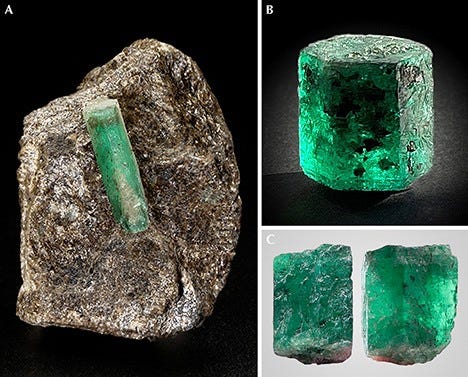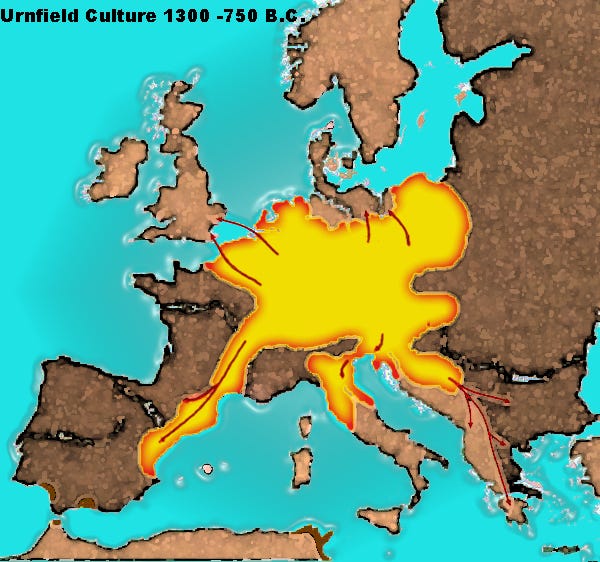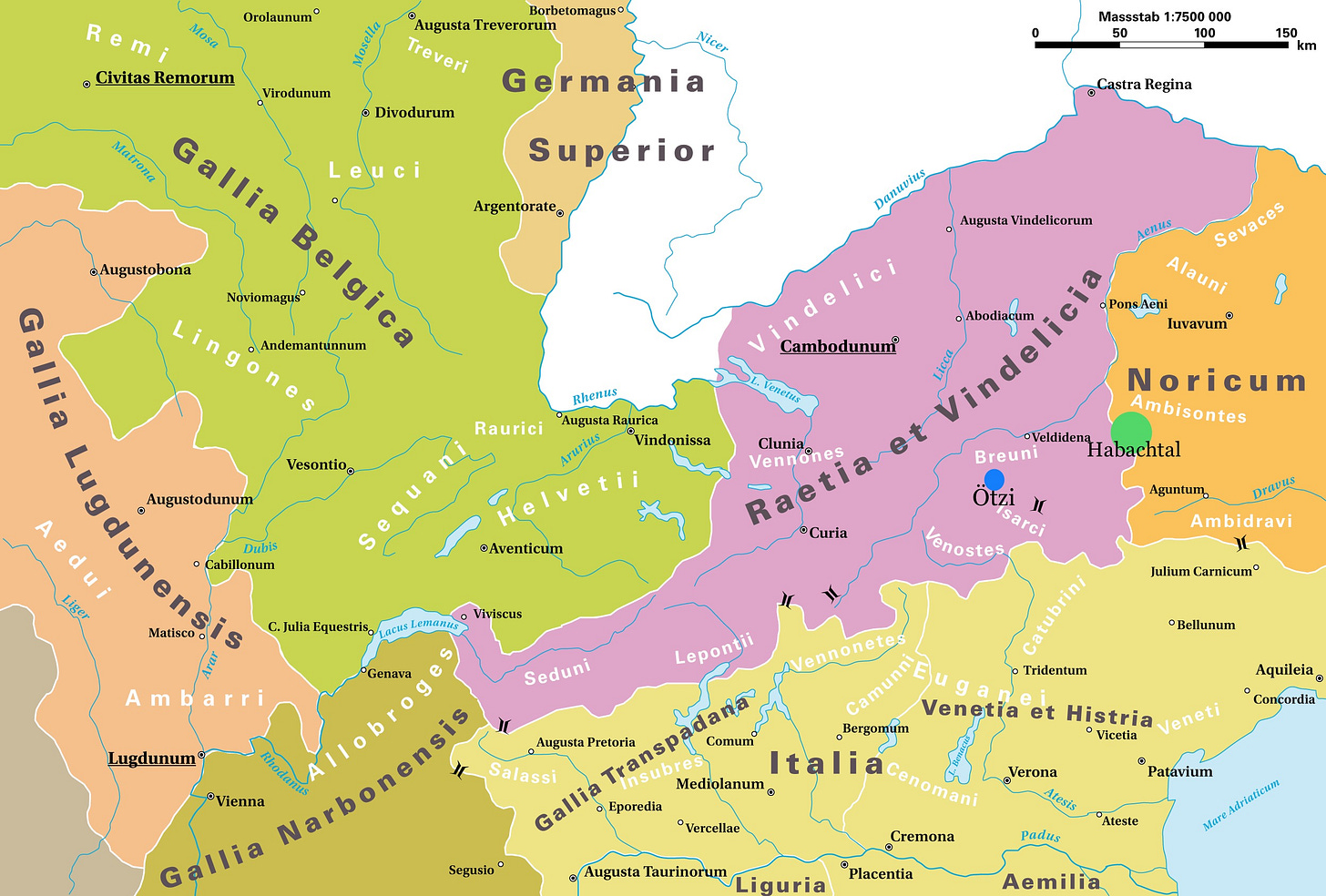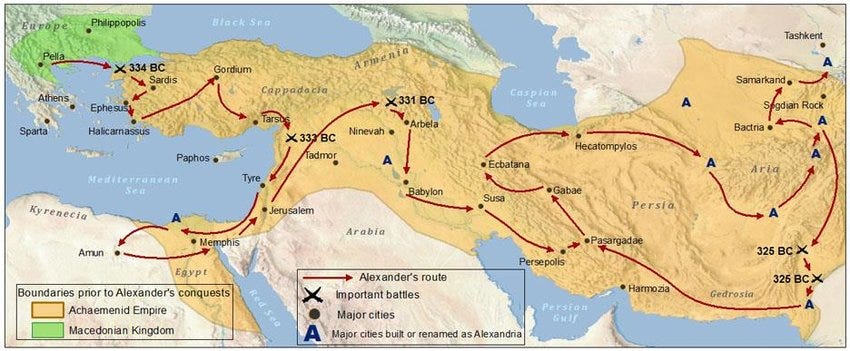Ancient Greek Σμᾰ́ραγδος (Smáragdos) is the word of origin for emeralds in many European languages, and the accepted etymology says that it was borrowed into Ancient Greek from a Semitic language root *BRK meaning “lightning”.
Instead, I invite you to consider two ideas to be further explored in this post:
Σμᾰ́ραγδος (smáragdos) is indeed a borrowed word, but from a source closer to the Ancient Greeks, and older than c. 350BC
The Ancient Greeks under Alexander brought the word σμάραγδος (smáragdos) with them and gave it to Persian and Sanskrit/Prakrit language speakers
This post then seeks to answer the following questions:
If the Ancient Greeks borrowed a word for emeralds before c. 350BC, then where did this word come from, who lived there, and what language did they speak?
Can the oldest form of the name σμᾰ́ραγδος (smáragdos) be reconstructed from roots in the language identified in the first question, and what does the name mean?
The following post is speculation and not a replacement for peer-reviewed scholarly work.
References:
Etymological Dictionary Of Proto Celtic
Matasović, Ranko (2009), Etymological Dictionary of Proto-Celtic (Leiden Indo-European Etymological Dictionary Series; 9), Leiden: Brill, →ISBN
Wikipedia (information)
Wiktionary (etymologies)
Σμᾰ́ραγδος (smáragdos) or Emerald:

From Wiktionary’s entry on the etymology of emerald:
From Middle English emeraude, borrowed from Old French esmeraude, from Vulgar Latin *smaralda, *smaraldus, *smaraudus, variant of Latin smaragdus, from Ancient Greek σμάραγδος (smáragdos), μάραγδος (máragdos), from a Semitic language.
Compare Hebrew בָּרֶקֶת (bareket, “emerald, flashing gem”) Akkadian 𒁀𒊏𒄣 (baraqu, literally “scintillation”), Arabic بَرْق (barq, literally “flashing”), Egyptian bwyrqꜣ (literally “to sparkle”)
The etymology from a Semitic language is further supported by:
It is established that emeralds were mined during the Ptolemaic, Roman, Byzantine, and Islamic eras in Egypt’s Eastern Desert, in the Wadi Sikait and Gebel Zabara regions.
According to the accepted etymology, the emerald trade out of Egypt made possible the importation of a Semitic word into Ancient Greek.
Questions for the accepted etymology
If Semitic *bait ('house') was borrowed and became Greek βῆτα bêta, why didn’t Ancient Greek scribes transcribe the initial Semitic B in baraḳ as a ‘B’ for σμάραγδος (smáragdos) too?
Did Ancient Greeks not know emeralds before the Ptolemaic dynasty controlled Egypt c. 300BC?
There is one major emerald source in Europe closer to the Ancient Greeks; wouldn’t the wealthy Athenians save some money and import from closer to home, and thus get the word σμάραγδος (smáragdos) from that place?
European emeralds
The Habachtal region of Austria is famous today as a tourist destination for hiking and mineral collecting in the famous Valley of Emeralds. As the National Park website notes, collectors make interesting finds regularly and the valley is the only major source of emeralds in Europe.
This valley is approximately 1,200 kilometers (850 miles) directly from Athens, and the Habachtal→Athens route could have been mostly nautical (overland from Habachtal to an Adriatic port, then sailing to Athens/Port of Piraeus). By comparison, emeralds sourced from Wadi Sikait or Gebel Zabara in Egypt had to travel directly more than 2,500 kilometers and over several bodies of water to reach Athens. Those direct measurements are only ‘as the crow flies’; the true distance was even more for both routes.
Identifying the language from the Habachtal before 350BC
Ötzi the Iceman was found about 223 kilometers (139 miles) via overland route from the Habachtal and died c. 3230BC. Ötzi’s Anatolian-heavy DNA indicates that his ancestors were part of the farming migration into Europe shown below:

Subsequent cultures covering the Alpine valleys included the Bronze Age Urnfield Cultures:

The Alpine valleys were thoroughly populated with Celtic speakers during the Roman Republic and early Roman Empire:

The attested presence of Celtic speaking settlements in the Alpine valleys during the Roman Republic and early Roman Empire make it plausible that Celtic speakers populated Alpine valleys before Alexander c. 350BC.
Proposed etymology from Proto-Celtic:
There are several possible ways to examine σμάραγδος (smáragdos) as an ancient Hellenization and evolution of a borrowed Proto-Celtic compound word. At first glance, it seems there could be many ways to look for Proto-Celtic roots by breaking the word in different places:
SMARAG-DOS, S-MARAG-DOS, SMAR-AGDOS…etc
However, adding an initial vowel helps to identify the initial breaks and then work backwards to Proto-Celtic roots:
US-MAR-AGDOS ← USS-MAR-AKTO ← UTS-MAR-AXTA
This reconstruction represents the following Proto-Celtic roots:
Root 1: Proto-Celtic *uts- prefix “out, up, off”
Compare: Old Irish terms prefixed with uss-
Root 2: Proto-Celtic *māros adjective “big, great”
Note: The Proto-Celtic word for shiny would be *gelos, but this has a sense of “shiny, white.” However, combining *uts- “out” with *mār “big, great” leads to a figurative sense of "to surpass in greatness" and to “outshine.”
Cognate: Proto-Germanic *mērijaz “renowned, famous, great”, the original meaning being "shining"
Root 3: Proto-Celtic *-axtā “-hood” or “-ness” forms abstract nouns
Compare: Old Irish terms suffixed with -acht
Creating a proposed compound word:
Proto-Celtic *utsmāraxtā “radiance, resplendence, shininess”
Compare this proposed meaning with Latin effulgens “radiant, resplendent, shining”(English Effulgent) created from a similar construction:
A Speculative Conclusion
Proto-Celtic speaking peoples inhabiting Alpine valleys had trade networks with that reached into Ancient Greece prior to Alexander the Great c. 356BC. A shared Urnfield cultural influence or heritage might be responsible for the emerald connection between the Aegean and the Habachtal (see Map 1).
This trade included a variety of Alpine crystals and minerals that Proto-Celtic speaking peoples are proposed to have described as *utsmāraxtā meaning “radiance, resplendence, and shininess.” The Alpine crystals, emeralds, and minerals may have been so valuable that their demand around the Mediterranean compelled Ötzi to risk seeking them in a guarded territory.
This post proposes that Ancient Greeks associated the generic Celtic description with the crystals they desired and imported most, the Habachtal emeralds:
Proto-Celtic *utsmāraxtā → ‘smāraxtā → Ancient Greek σμάραγδος (smáragdos)
As a result of Alexander’s conquests, Ancient Greek σμάραγδος was adopted into Persian and Sanskrit/Prakrit and then to more languages (only a partial list):
σμάραγδος → Persian زمرد (zomorrod) “emerald” →
Old Armenian զումուրուխտ (*zumuruxt)
Old Georgian ზურმუხტი (zurmuxṭi)
σμάραγδος → Sanskrit मरकत (marakata) “emerald” →

Although the accepted etymology states that Ancient Greek σμάραγδος is from Semitic *baraḳ “lightning”, there are more questions raised than answered with this explanation:
Ancient Greek scribes could have more faithfully transcribed the Semitic root BRK sound by starting with β. The silvery darting fish called βάρακoς (bárakos) seems more likely to be the borrowed term from the Semitic BRK root. Other constructions with β- or similar like μπάρακoς (bárakos), βάραγδος or μπάραγδος (báragdos) might have been possible, but none of those are attested.
Semitic BRK seems most similar to two existing words with uncertain etymologies in Greek: a flashy freshwater fish, βάρακoς (bárakos), suggested by the Diccionario Griego–Español to be the European perch, or related to βάλαγρος (bálagros), suggested to be a type of catfish, possibly Aristotle’s catfish or Wels catfish
Any simplifications through borrowing implies that SMRGD to BRK is more likely than the other way around.
None of the Semitic languages except Hebrew בָּרֶקֶת (bareket) “emerald, flashing gem” connects a meaning directly to emerald like Greek, Persian, Sanskrit, and their descendants. Other Semitic language BRK stems are more general; with meanings of “flash, gleam”.
***
Some famous Habachtal emeralds have exceeded 40 carats, and some Middle Ages specimens may have been reused from ancient jewelry. Even today, Habachtal emeralds are valued for their brilliance, meaning the amount of light and reflection that comes out of the interior of a stone- or in layman's terms- how much it shines or sparkles:

Thank you for reading. Nick DeSoto “Dad in SoCal” 11 October 2023 @ 1550



